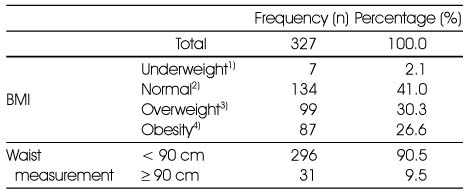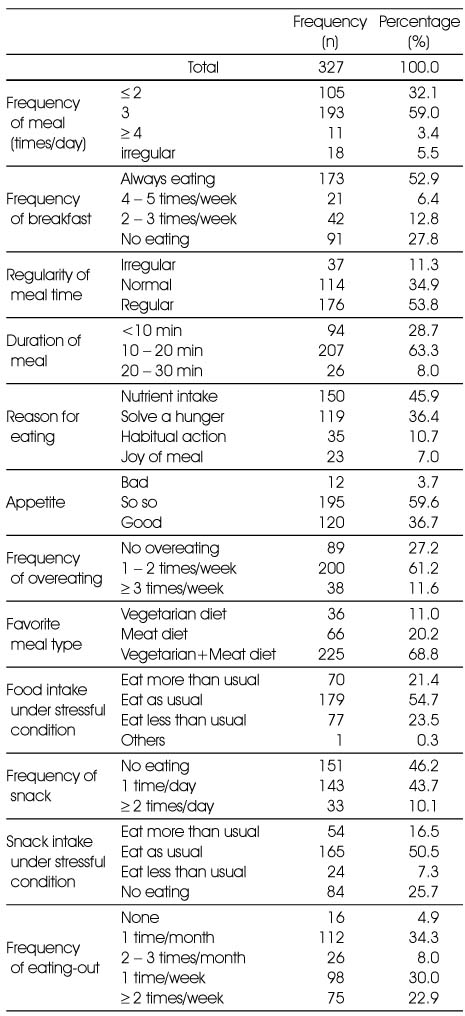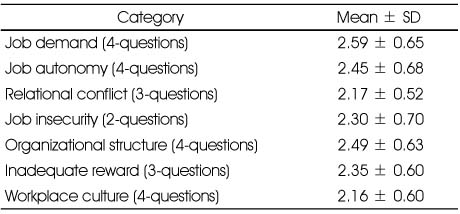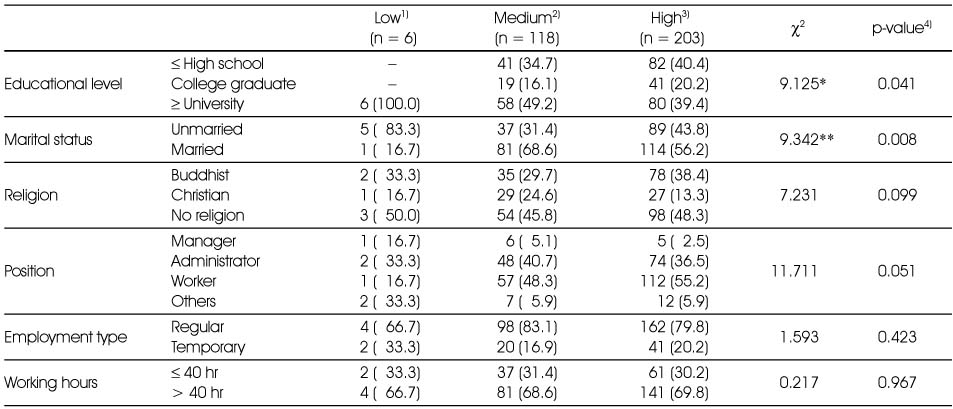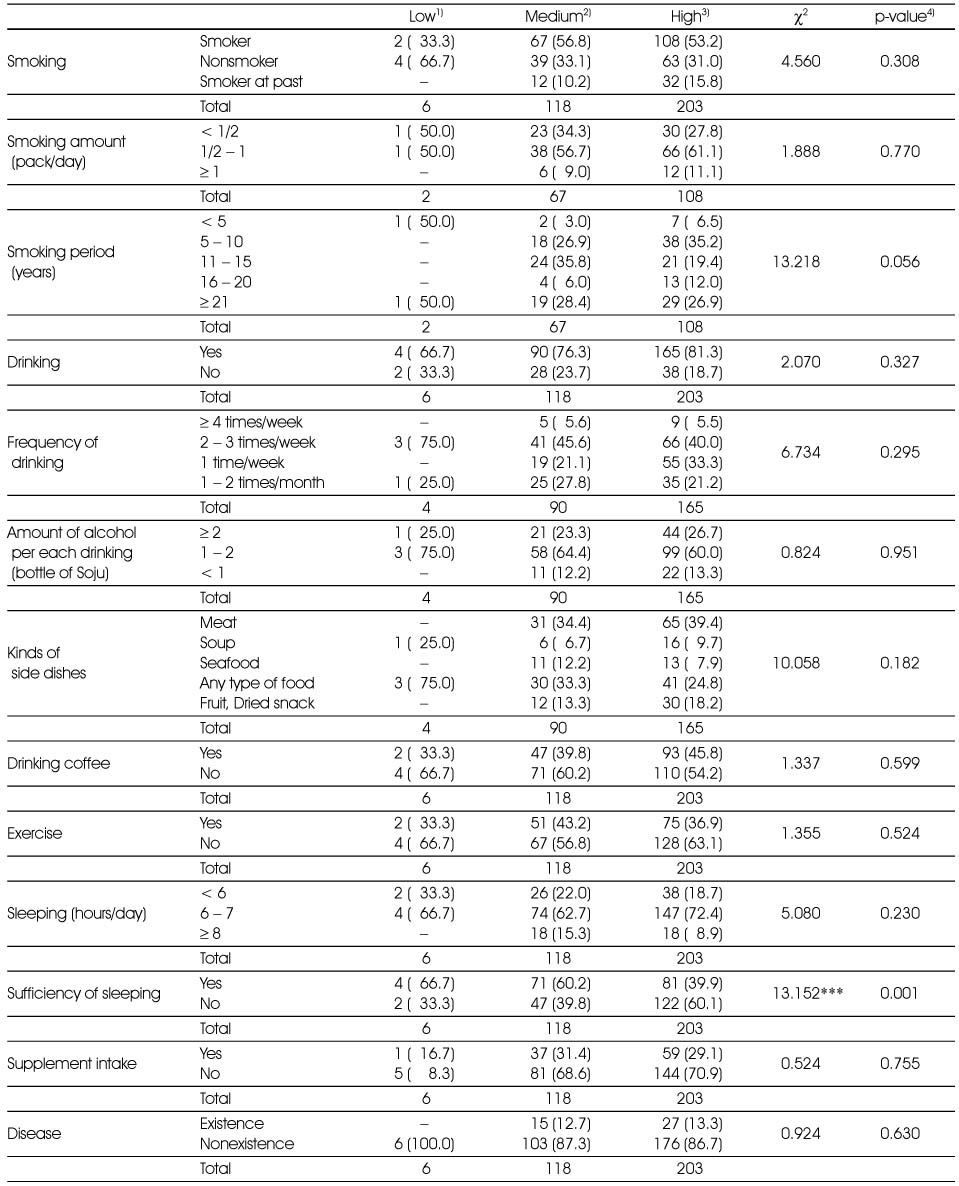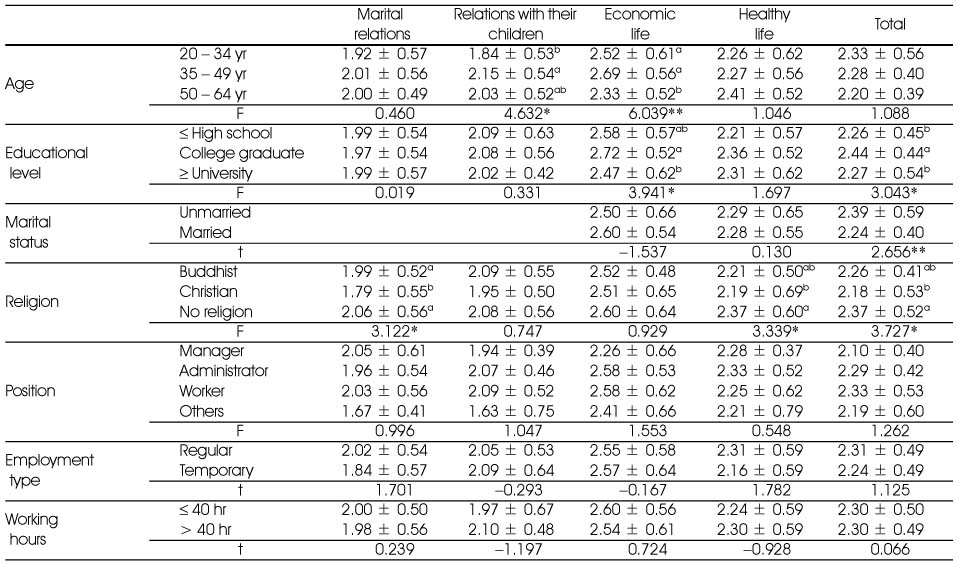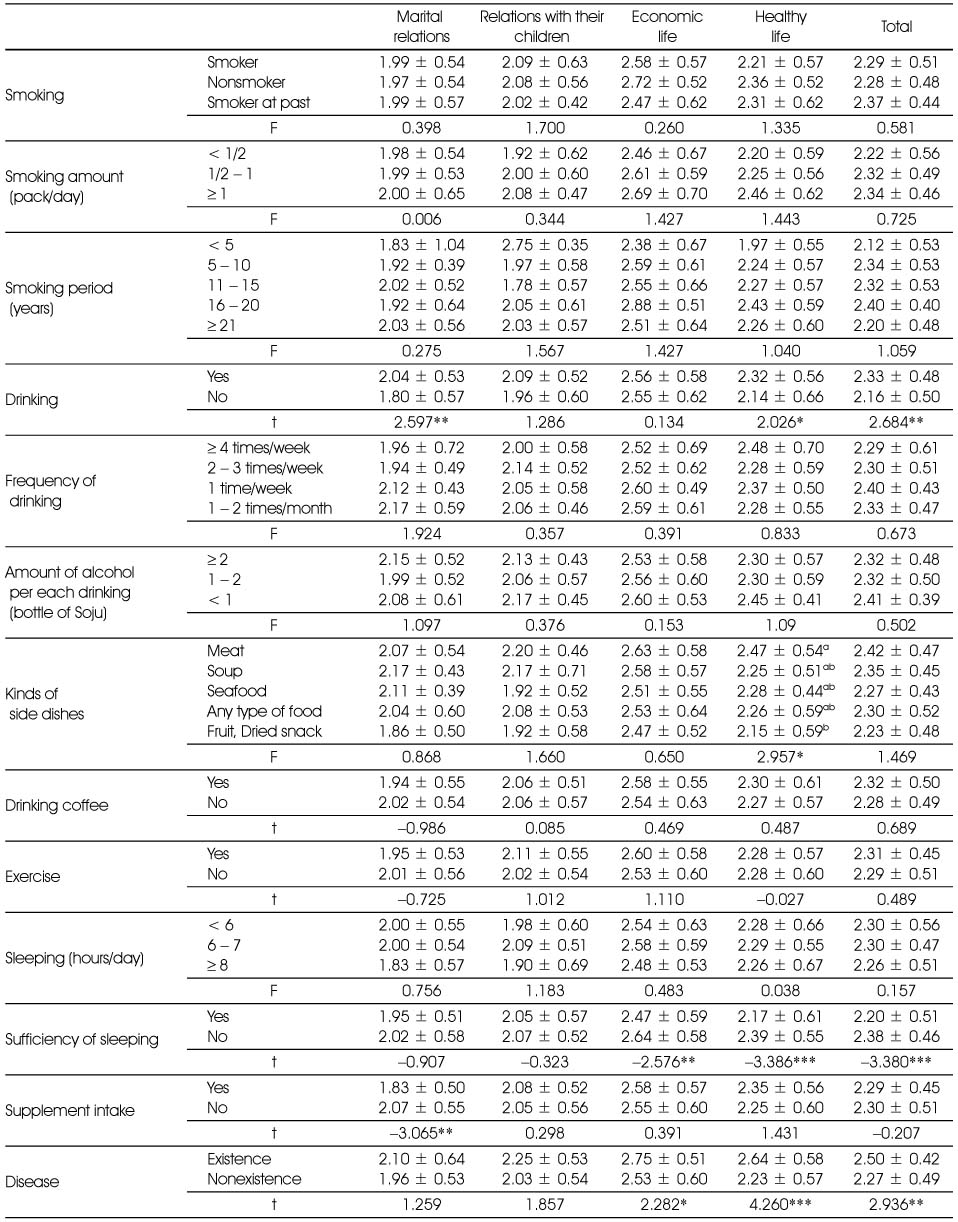References
1. Adler N, Metthews K. Health psychology: why do somepeople get sick and some stay well? Annu Rev Psychol 1994. 45229–259.
2. Ahn B, Kim SY. A study on the eating behaviors and the preferences of industrial workers in Korea. J East Asian Soc Diet Life 1999. 9(3)336–344.
3. Angus J, Rukholm E, Onge R, Michel I, Nolan RP, Lapum J, Evans S. Habitus stress and the body: the everyday production of health and cardiovascular risk. Qual Health Res 2007. 17(8)1088–1102.
4. Ashwell M, Cole TJ, Dixon AK. Obesity: new insight into the anthropometric classification of fat distribution shown by computed tomography. Br Med J 1985. 2901692–1694.
5. Boyle MA, Morris DH. Community nutrition in action 1999. 2nd edth ed. Belmont CA: West/Wadworth; 236–259.
6. Campbell A, Converse PE, Rodgers WL. The quality of American life. J Personal Soc Psychol 1976. 47156–163.
7. Chang SJ, Koh SB, Kang MK, Cha BS, Park JK, Hyun SJ, Park JH, Kim SA, Kang DM, Chang SS, Lee KJ, Ha EH, Ha M, Woo JM, Cho JJ, Kim HS, Park JS. Epidemiology of psychosocial distress in Korean employees. J Prev Med Public Health 2005. 38(1)25–37.
8. Cho TR. Workers' job stress status and related factors-using Korean occupational stress questionnaire short form. Korean J Occup Health Nurs 2006. 15(1)58–71.
9. Cho KO, Lee HJ. The effects of regular exercise on obesity indices and dietary factors in adult males. Korean J Community Nutr 2007. 12(2)160–167.
10. Choi ES, Ha YM. Work-related stress and risk factors among Korean employees. J Korean Acad Nurs 2009. 39(4)549–561.
11. Choi JS, Jee SM, Baek HY, Hong SM. A study on the eating habits and dietary consciousness of adults in urban area. J Korean Soc Food Sci Nutr 2003. 32(7)1132–1146.
12. Choi MK, Kim JM, Kim JK. A study on the dietary habit and health of office workers in Seoul. Korean J Food Cult 2003. 18(1)45–55.
13. Dennis JP, Markey MA, Johnston KA, Vander Wal JS, Artinian NT. The role of stress and social support in predicting depression among a hypertensive African American sample. Heart Lung 2008. 37(2)105–112.
14. Fuller j, Schaller-Ayers j. Health assessment: A nursing approach 2000. Philadelphia: Lippincott;
15. Glanz K, Lewis FM, Rimer BK. Health behavior and health education-theory, research and practice 1990. San Francisco: Jossey-Bass;
16. Han KL. A study on the relationship between the stress of middlelife men and climacteric symptom 2002. Chung-Ang University; 2–5.
MS thesis.
17. Han KL, Chung YK, Lee JO. A study on the relationship between the stress and climatric symtoms of middlelife men. J Korean Community Nurs 2002. 13(3)513–522.
18. Hong WS, Jang MR. Analysis of nutrition service needs and proposal of the role of dietitian for office worker. J Korean Diet Assoc 1996. 2(1)55–113.
19. Hughes BM. Individual difference in hostility and habituation of cardiovascular reactivity to stress. Stress Health 2007. 23(1)37–42.
20. Jang HS, Choi JH. The health status according to the age and BMI of male workers in Daegu·Gyeongbuk region. J Korean Soc Food Sci Nutr 2007. 36(3)318–326.
21. Jeffery RW, Ng DM. Relationships between perceived stress and health behaviors in a sample of working adults. Health Psychol 2003. 22(6)638–642.
22. Jun YS, Choi MK. Effect of academic examination stress on taste perception and nutrient intake in university students. J Korean Soc Food Sci Nutr 2004. 33(2)349–355.
23. Kim DH, Kim HD. Stress-related socio-demographic factors and life style on male white collar workers. J Korean Soc Health Educ Promot 2002. 19(2)45–55.
24. Kim HK, Kim JH. Relationship between stress and eating habits of adults in Ulsan. Korean J Nutr 2009. 42(6)536–546.
25. Kim JG, Kim JM, Choi MK. A study on the stress and dietary life of office workers in Seoul. Korean J Food Cookery Sci 2003. 19(4)413–422.
26. Kim M, Jung DY, Park HJ. A study on perceived and dietary habits of female college students. Korean J Women Health Nurs 2008. 14(3)181–188.
27. Kim SM, Lee DJ. What is the best simple anthropometric indicis of abd-ominal visceral fat in Korean obese patients? Korean J Obes 1998. 7(2)157–168.
28. Kim SS. A study on influential factors underlying middle-aged men's stress 2001. Mokwon University; 5–20.
MS thesis.
29. Kim YM. Work·family role burden and psychological well-being of Korean men in the middle-aged 2003. Kunsan National University; MS thesis.
30. Korean Society of Occupational Stress. Korean occupational stress guestionnaine short form 2005.
31. Kouvonen A, Kivimaki M, Cox SJ, Cox T. Relationship between work stress and body mass index among 45, 810 female and male employees. Psychosom Med 2005. 67(4)577–583.
32. Lee SY, Park HS, Kim DJ, Han JH, Kim SM, Cho GJ, Kim DY, Kwon HS, Kim SR, Lee CB, Oh SJ, Park CY, Yoo HJ. Appropriate waist circumference cutoff points for central obesity in Korean adults. Diabetes Res Clin Pract 2007. 75(1)72–80.
33. Lee YS. The relationship between stress and health habits in industrial workers. Korean J Prev Med 1990. 23(1)33–42.
34. Lee HJ, Jekarl J. Survey on alcohol use of workers for developing employee assistance program 2002. Seoul: Korea Drinking Culture and Alcohol Research Foundation;
35. Mckeown T. The role of medicine 1984. Oxford: Basil Blackwell;
36. Ministry of Health and Welfare. The Korea National Health and Nutrition Examination Survey 2005.
37. Myung CO, Nam HW, Park YS. A study of stress, food habits and well-being related attitudes in urban middle-aged men. J East Asian Soc Diet Life 2009. 19(2)157–168.
38. Owens JF, Matthews KA. Sleep disturbance in healthy middle-aged women. Maturitas 1998. 30(1)41–50.
39. Park SB. Recognition status of health related to smoking, alcohol drinking, and stress in a working place. J Korean Acad Fam Med 2001. 22(12)1814–1822.
40. Park SM, Kim JY, Jang IS, Park EJ. Severity of insomnia, depression, and quality of life in elderly. J Korean Gerontol Soc 2008. 28(4)991–1007.
41. Polzer Casarez RL, Miles MS. Spirituality: a cultural strength for African American mothers with HIV. Clin Nurs Res 2008. 17(2)118–132.
42. Pouliot MC, Després JP. Waist circumference and abdominal sagittal diameter: best simple anthropometric indexes of abdominal visceral adipose tissue accumulation and related cardiovascular risk in men and women. Am J Cardiol 1994. 73(7)460–468.
43. Schuler RS. Definition and conceptualization of stress in organization. Organ Behav Hum Perform 1980. 25(13)184–215.
44. Shin YJ. Study on the dietary habit and behavior of office men in the city 1997. Hyosung University; MS thesis.
45. The Korea National Statistical Office. Questionnaire for the economically active population survey 2006.
46. The Korean Society of Community Nutrition. Questionnaire book related to nutrition 2000. Seoul:
47. Theorell T, Perski A, Akerstedt T, Sigala F, Ahlgerg-Hulten G, Svensson J. Changes in job strain in relation to changes in physiological state. a longitudinal study. Scand J Work Environ Health 1988. 14(3)189–196.
48. Woo JM. Effects of cognitive-behavioral methods of stress management for workers. Cognitive Behav Ther Korea 2005. 5(1)43–52.
49. Yun SH, Bae JI, Lee SW, Ahn KA, Kim SE. The effects of job stress on depression, drinking and smoking among Korean men. Health Soc Sci 2006. 1931–50.

